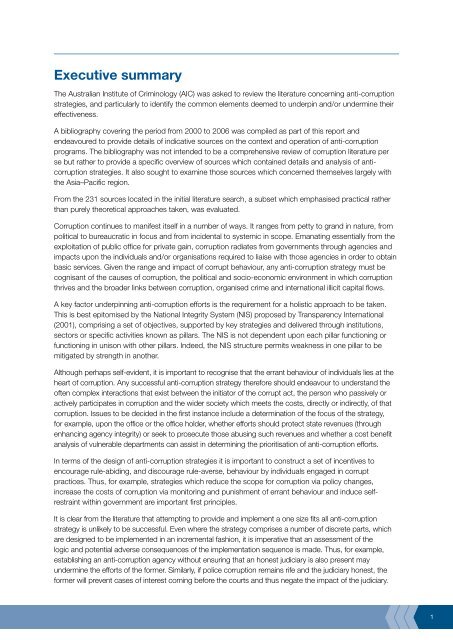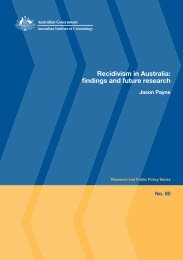Review of anti-corruption strategies Rob McCusker - Australian ...
Review of anti-corruption strategies Rob McCusker - Australian ...
Review of anti-corruption strategies Rob McCusker - Australian ...
You also want an ePaper? Increase the reach of your titles
YUMPU automatically turns print PDFs into web optimized ePapers that Google loves.
Executive summary<br />
The <strong>Australian</strong> Institute <strong>of</strong> Criminology (AIC) was asked to review the literature concerning <strong>anti</strong>-<strong>corruption</strong><br />
<strong>strategies</strong>, and particularly to identify the common elements deemed to underpin and/or undermine their<br />
effectiveness.<br />
A bibliography covering the period from 2000 to 2006 was compiled as part <strong>of</strong> this report and<br />
endeavoured to provide details <strong>of</strong> indicative sources on the context and operation <strong>of</strong> <strong>anti</strong>-<strong>corruption</strong><br />
programs. The bibliography was not intended to be a comprehensive review <strong>of</strong> <strong>corruption</strong> literature per<br />
se but rather to provide a specific overview <strong>of</strong> sources which contained details and analysis <strong>of</strong> <strong>anti</strong><strong>corruption</strong><br />
<strong>strategies</strong>. It also sought to examine those sources which concerned themselves largely with<br />
the Asia–Pacific region.<br />
From the 231 sources located in the initial literature search, a subset which emphasised practical rather<br />
than purely theoretical approaches taken, was evaluated.<br />
Corruption continues to manifest itself in a number <strong>of</strong> ways. It ranges from petty to grand in nature, from<br />
political to bureaucratic in focus and from incidental to systemic in scope. Emanating essentially from the<br />
exploitation <strong>of</strong> public <strong>of</strong>fice for private gain, <strong>corruption</strong> radiates from governments through agencies and<br />
impacts upon the individuals and/or organisations required to liaise with those agencies in order to obtain<br />
basic services. Given the range and impact <strong>of</strong> corrupt behaviour, any <strong>anti</strong>-<strong>corruption</strong> strategy must be<br />
cognisant <strong>of</strong> the causes <strong>of</strong> <strong>corruption</strong>, the political and socio-economic environment in which <strong>corruption</strong><br />
thrives and the broader links between <strong>corruption</strong>, organised crime and international illicit capital flows.<br />
A key factor underpinning <strong>anti</strong>-<strong>corruption</strong> efforts is the requirement for a holistic approach to be taken.<br />
This is best epitomised by the National Integrity System (NIS) proposed by Transparency International<br />
(2001), comprising a set <strong>of</strong> objectives, supported by key <strong>strategies</strong> and delivered through institutions,<br />
sectors or specific activities known as pillars. The NIS is not dependent upon each pillar functioning or<br />
functioning in unison with other pillars. Indeed, the NIS structure permits weakness in one pillar to be<br />
mitigated by strength in another.<br />
Although perhaps self-evident, it is important to recognise that the errant behaviour <strong>of</strong> individuals lies at the<br />
heart <strong>of</strong> <strong>corruption</strong>. Any successful <strong>anti</strong>-<strong>corruption</strong> strategy therefore should endeavour to understand the<br />
<strong>of</strong>ten complex interactions that exist between the initiator <strong>of</strong> the corrupt act, the person who passively or<br />
actively participates in <strong>corruption</strong> and the wider society which meets the costs, directly or indirectly, <strong>of</strong> that<br />
<strong>corruption</strong>. Issues to be decided in the first instance include a determination <strong>of</strong> the focus <strong>of</strong> the strategy,<br />
for example, upon the <strong>of</strong>fice or the <strong>of</strong>fice holder, whether efforts should protect state revenues (through<br />
enhancing agency integrity) or seek to prosecute those abusing such revenues and whether a cost benefit<br />
analysis <strong>of</strong> vulnerable departments can assist in determining the prioritisation <strong>of</strong> <strong>anti</strong>-<strong>corruption</strong> efforts.<br />
In terms <strong>of</strong> the design <strong>of</strong> <strong>anti</strong>-<strong>corruption</strong> <strong>strategies</strong> it is important to construct a set <strong>of</strong> incentives to<br />
encourage rule-abiding, and discourage rule-averse, behaviour by individuals engaged in corrupt<br />
practices. Thus, for example, <strong>strategies</strong> which reduce the scope for <strong>corruption</strong> via policy changes,<br />
increase the costs <strong>of</strong> <strong>corruption</strong> via monitoring and punishment <strong>of</strong> errant behaviour and induce selfrestraint<br />
within government are important first principles.<br />
It is clear from the literature that attempting to provide and implement a one size fits all <strong>anti</strong>-<strong>corruption</strong><br />
strategy is unlikely to be successful. Even where the strategy comprises a number <strong>of</strong> discrete parts, which<br />
are designed to be implemented in an incremental fashion, it is imperative that an assessment <strong>of</strong> the<br />
logic and potential adverse consequences <strong>of</strong> the implementation sequence is made. Thus, for example,<br />
establishing an <strong>anti</strong>-<strong>corruption</strong> agency without ensuring that an honest judiciary is also present may<br />
undermine the efforts <strong>of</strong> the former. Similarly, if police <strong>corruption</strong> remains rife and the judiciary honest, the<br />
former will prevent cases <strong>of</strong> interest coming before the courts and thus negate the impact <strong>of</strong> the judiciary.















